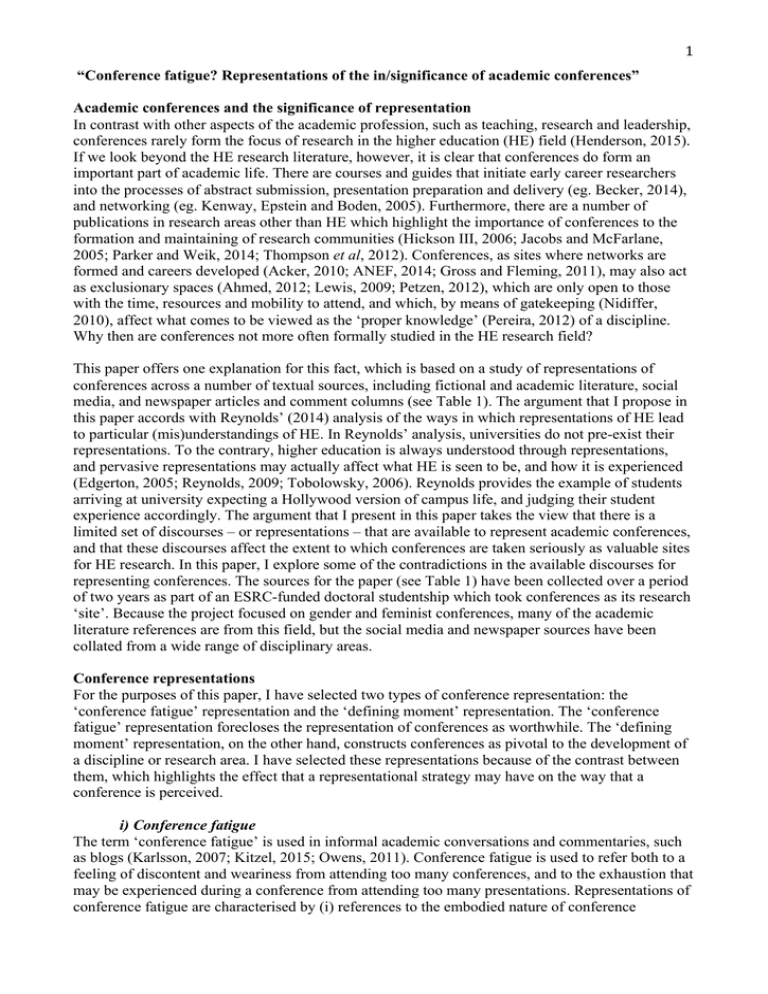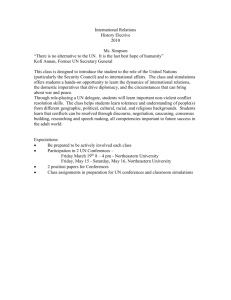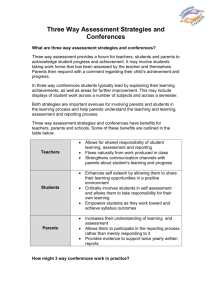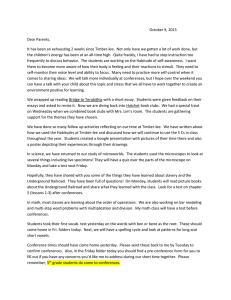Document 12700753
advertisement

1 “Conference fatigue? Representations of the in/significance of academic conferences” Academic conferences and the significance of representation In contrast with other aspects of the academic profession, such as teaching, research and leadership, conferences rarely form the focus of research in the higher education (HE) field (Henderson, 2015). If we look beyond the HE research literature, however, it is clear that conferences do form an important part of academic life. There are courses and guides that initiate early career researchers into the processes of abstract submission, presentation preparation and delivery (eg. Becker, 2014), and networking (eg. Kenway, Epstein and Boden, 2005). Furthermore, there are a number of publications in research areas other than HE which highlight the importance of conferences to the formation and maintaining of research communities (Hickson III, 2006; Jacobs and McFarlane, 2005; Parker and Weik, 2014; Thompson et al, 2012). Conferences, as sites where networks are formed and careers developed (Acker, 2010; ANEF, 2014; Gross and Fleming, 2011), may also act as exclusionary spaces (Ahmed, 2012; Lewis, 2009; Petzen, 2012), which are only open to those with the time, resources and mobility to attend, and which, by means of gatekeeping (Nidiffer, 2010), affect what comes to be viewed as the ‘proper knowledge’ (Pereira, 2012) of a discipline. Why then are conferences not more often formally studied in the HE research field? This paper offers one explanation for this fact, which is based on a study of representations of conferences across a number of textual sources, including fictional and academic literature, social media, and newspaper articles and comment columns (see Table 1). The argument that I propose in this paper accords with Reynolds’ (2014) analysis of the ways in which representations of HE lead to particular (mis)understandings of HE. In Reynolds’ analysis, universities do not pre-exist their representations. To the contrary, higher education is always understood through representations, and pervasive representations may actually affect what HE is seen to be, and how it is experienced (Edgerton, 2005; Reynolds, 2009; Tobolowsky, 2006). Reynolds provides the example of students arriving at university expecting a Hollywood version of campus life, and judging their student experience accordingly. The argument that I present in this paper takes the view that there is a limited set of discourses – or representations – that are available to represent academic conferences, and that these discourses affect the extent to which conferences are taken seriously as valuable sites for HE research. In this paper, I explore some of the contradictions in the available discourses for representing conferences. The sources for the paper (see Table 1) have been collected over a period of two years as part of an ESRC-funded doctoral studentship which took conferences as its research ‘site’. Because the project focused on gender and feminist conferences, many of the academic literature references are from this field, but the social media and newspaper sources have been collated from a wide range of disciplinary areas. Conference representations For the purposes of this paper, I have selected two types of conference representation: the ‘conference fatigue’ representation and the ‘defining moment’ representation. The ‘conference fatigue’ representation forecloses the representation of conferences as worthwhile. The ‘defining moment’ representation, on the other hand, constructs conferences as pivotal to the development of a discipline or research area. I have selected these representations because of the contrast between them, which highlights the effect that a representational strategy may have on the way that a conference is perceived. i) Conference fatigue The term ‘conference fatigue’ is used in informal academic conversations and commentaries, such as blogs (Karlsson, 2007; Kitzel, 2015; Owens, 2011). Conference fatigue is used to refer both to a feeling of discontent and weariness from attending too many conferences, and to the exhaustion that may be experienced during a conference from attending too many presentations. Representations of conference fatigue are characterised by (i) references to the embodied nature of conference 2 attendance and (ii) comic devaluation of the significance of conferences as sites of academic knowledge production. Conference fatigue representations thus often focus on the ‘non-academic’ facets of conference attendance, such as travel and airports, accommodation, clothing, food, alcohol, small-talk and gossip, disco dancing, illness, and sex. These representations focus on the physical constraints (and temptations) that prevent a conference delegate from fully accessing the ‘content’ of the conference presentations. Constraints include fatigue from travel, jetlag, hunger and hang-over; temptations include meeting old friends and making new friends: these constraints and temptations are portrayed either as leading to non-attendance of sessions or as an impediment to concentrating in sessions. Conference fatigue representations capitalise on the bathetic juxtaposition of abstract knowledge production with the bodies who produce this knowledge. ii) Defining moment In contrast to the ‘conference fatigue’ representation, the ‘defining moment’ representation refers to a particular conference as the moment where a discipline changed track or a research area was founded. As such this representation in fact solely concentrates on the ‘official content’ of the conference, often a keynote presentation or plenary panel and the ensuing discussion. Defining moment representations are often characterised by a lack of any detail about the conference at all. A typical ‘defining moment’ representation states the year, the name and location of the conference, and the transformation that occurred: ‘The 1994 Queer Studies Conference at the University of Iowa fostered the first truly international network of emerging transgender scholars’ (Stryker, 2006). Defining moment representations often occur in academic literature, where they serve as markers in chronological accounts of research fields. The (in)significance of conferences In bringing together the ‘conference fatigue’ and ‘defining moment’ representations of conferences, I have shown the contrasts and contradictions in different modes of representation. On the one hand, the conference fatigue representation, which focuses on the embodied rituals and practices of conference attendance, forecloses engagement with the academic knowledge production of a conference. On the other hand, the defining moment representation, which transforms the conference into an abstract signifier for a shift in a discipline, elides the complexity and heterogeneity of any conference experience. With reference to the aforementioned research on the effects that available representations – and representational strategies – may have on the possibilities for understanding an HE phenomenon, this paper concludes that analysing representations of academic conferences is an important step in establishing conferences as a site for HE research. References Acker, S. (2010). ‘Gendered Games in Academic Leadership’. International Studies in Sociology of Education, 20 (2), 129-152. Ahmed, S. (2012). On being included: racism and diversity in institutional life. Durham, NC: Duke University Press. ANEF (Association nationale des études féministes). (2014). Le genre dans l'enseignement supérieur et la recherche: livre blanc. Paris: la Dispute. Becker, L. M. (2014). Presenting your research: conferences, symposiums, poster presentations and beyond. London: SAGE Publications. Edgerton, S. H. (2005). Imagining the academy: higher education and popular culture. New York, NY; London: RoutledgeFalmer. Gross, N. and Fleming, C. (2011). ‘Academic conferences and the making of philosophical knowledge’. In C. Camic, N. Gross and M. Lamont (Eds), Social knowledge in the making (pp. 151-179). Chicago, IL: University of Chicago Press. Henderson, E. F. (2015). ‘Academic conferences: representative and resistant sites for higher education research’. Higher Education Research & Development, 1-12. 3 Hickson III, M. (2006). ‘Raising the Question #4 Why Bother Attending Conferences?’. Communication Education, 55 (4), 464-468. Jacobs, N. and McFarlane, A. (2005). ‘Conferences as learning communities: some early lessons in using “back-channel” technologies at an academic conference – distributed intelligence or divided attention?’. Journal of Computer Assisted Learning, 21 (5), 317-329. Karlsson, R. (2007). ‘Conference fatigue’, Rawls and me, last accessed 19 June 2015, http://rawlsandme.blogspot.co.uk/2007/05/conference-fatigue.html Kenway, J., Epstein, D. and Boden, R. (2005). Building networks. London: SAGE Publications. Kitzel, M. B. (2015). Conference fatigue, mbkitzel, last accessed 19 June 2015, https://mbkitzel.wordpress.com/2015/04/22/conference-fatigue/. Lewis, G. (2009). ‘Celebrating Intersectionality? Debates on a Multi-faceted Concept in Gender Studies: Themes from a Conference’. European Journal of Women’s Studies, 16 (3), 203210. Nidiffer, J. (2010). ‘Corrective lenses: suffrage, feminist poststructural analysis, and the history of higher education’. In E. J. Allan, S. V. D. Iverson and B. Ropers-Huilman (Eds), Reconstructing policy in higher education: feminist poststructural perspectives (pp. 41-62). New York, NY; London: Routledge. Owens, T. (2011). Conference fatigue, timowens, last accessed 19 June 2015, http://blog.timowens.io/conference-fatigue/ Parker, M. and Weik, E. (2014). ‘Free spirits? The academic on the aeroplane’. Management Learning, 45 (2), 167-181. Pereira, M. d. M. (2012). ‘“Feminist theory is proper knowledge, but...”: The status of feminist scholarship in the academy’. Feminist Theory, 13 (3), 283-303. Petzen, J. (2012). ‘Queer Trouble: Centring Race in Queer and Feminist Politics’. Journal of Intercultural Studies, 33 (3), 289-302. Reynolds, P. J. (2009). ‘The Celluloid Ceiling: Women Academics, Social Expectations, and Narrative in 1940s American Film’. Gender and Education, 21 (2), 209-224. Reynolds, P. J. (2014). Representing ‘U’: popular culture, media, and higher education. San Francisco, California: ASHE (Association for the Study of Higher Education). Stryker, S. (2006). ‘(De)Subjugated knowledges: an introduction to Transgender Studies’. In S. Stryker and S. Whittle (Eds), The transgender studies reader (pp. 1-17). New York: Routledge. Thompson, A., Brookins-Fisher, J., Kerr, D. and O'Boyle, I. (2012). ‘Ethical issues in professional development: Case studies regarding behaviour at conferences’. Health Education Journal, 71 (5), 539-545. Tobolowsky, B. F. (2006). ‘Beyond demographics: Understanding the college experience through television’. New Directions for Student Services, 2006 (114), 17-26. 4 Table 1 - Representations of academic conferences: sources by type Type of Source Academic journal article Academic book or book chapter Conference paper/ seminar Novel or short story Blog post Facebook post Times Higher Education or other magazine Records of conversations TOTAL Total number of sources included for study 28 Total number of sources referred to for ‘conference fatigue’ 10 Total number of sources referred to for ‘defining moment’ 9 22 5 13 6 2 4 4 6 5 23 3 6 4 8 2 0 0 5 6 5 1 100 43 34


![[Today’s Date] [Your Supervisor’s First Name] [Your School or District’s Name]](http://s2.studylib.net/store/data/010451343_1-ed5410b4013e6d3fbc1a9bbd91a926a9-300x300.png)



